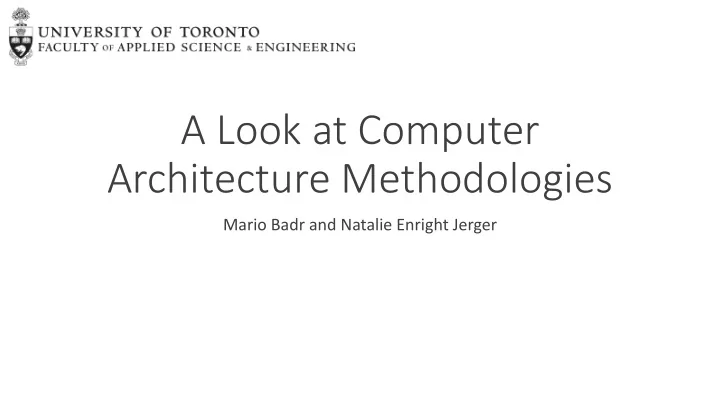

A Look at Computer Architecture Methodologies Mario Badr and Natalie Enright Jerger
Why evaluation methodologies? 1. Is computer architecture an art or a science? • Experimental Data • Reproducibility 2. How have evaluated metrics changed over the years? 2
Scope of the Survey • 44 ISCA Proceedings • 1973-2017 • Too many papers (over 1600) • Select papers from each proceeding across topics • Bias selection to impactful papers • 4-7 papers per proceeding • 222 papers total 3
Paper Topics Axis #1 Description Single Core A conventional general purpose processor with one core Multiple Core More than one conventional processor Specialized Architecture An unconventional processor (e.g., accelerator, GPU) Axis #2 Description or Examples Microarchitecture e.g., branch prediction, simultaneous multithreading Memory e.g., cache replacement, phase change memory, cache coherence, memory consistency Networks e.g., bus, crossbar, network-on-chip, network interface Organization The overall design of multiple components Coordination The management of multiple components to achieve a goal 4
Surveyed Papers Along Both Axes Memory Microarchitecture Networks Organization Coordination Specialized Architecture Single Core Multiple Cores 0 20 40 60 80 100 120 140 Paper Count 5
Types of Evaluations • None • Qualitative • Theoretical • Quantitative • Experimental data 6
We Focus on Quantitative Evaluations • None • Analytical Model • Qualitative • Prototype • Theoretical • Simulation • Architectural • Circuit-level • Quantitative • Other • Experimental data 7
The 1970s – 27 papers • Quantitative Evaluations: 40% Memory Microarchitecture Networks Organization 8 • Evaluated Metrics 7 6 • Performance Paper Count 5 • Proxies for area 4 3 • Analytical Models 2 1 • e.g., assume ideal parallelism 0 • e.g., performance projections Analytical Model Architectural Other Simulation 8
The 1980s – 46 papers • Quantitative Evaluations: 60% Memory Microarchitecture Networks Organization Coordination • Reduced costs of memory and 18 16 CPU 14 • Single core processors Paper Count 12 10 • Prototyping 8 6 4 • Trace-driven simulation 2 0 Analytical Model Architectural Prototyping Simulation 9
The 1990s – 47 papers • Quantitative Evaluations: 85% Memory Microarchitecture Networks Organization 35 • Introduction of many simulators 30 • SimpleScalar 25 Paper Count 20 15 • Introduction of CACTI 10 • Catches on in the next decade 5 0 Analytical Model Architectural Prototyping • Power/energy is considered Simulation 10
A Brief Interlude: Evaluated Metrics 1973 – 1995 1996 – 2017 100% 100% Percentage of Papers 90% 90% 80% 80% 70% 70% 60% 60% 50% 50% 40% 40% 30% 30% 20% 20% 10% 10% 0% 0% Performance Power Energy Area Performance Power Energy Area 11
The 2000s – 50 papers • Quantitative Evaluations: 98% Memory Microarchitecture Networks Organization Coordination • Models for power, energy, thermal 50 • Wattch, HotSpot, Orion, McPAT 45 • CACTI gains popularity 40 35 Paper Count 30 • More simulator options 25 20 • Pin, Simics 15 10 5 • Tools to reduce simulation time 0 • SimPoint, PinPoint, SMARTS Analytical Model Architectural Prototyping Simulation 12
The 2010s – 52 papers • Models and prototypes used Memory Microarchitecture more Networks Organization Coordination 50 45 • More tools 40 35 • Raised levels of abstraction Paper Count 30 • Design space exploration 25 20 15 10 5 0 Analytical Model Architectural Prototyping Simulation 13
Summarizing Tool Use – 1973 - 2017 50 45 40 35 Paper Count 30 25 20 15 10 5 0 1970s 1980s 1990s 2000s 2010s 1970s 1980s 1990s 2000s 2010s 1980s 1990s 2000s 2010s Analytical Model Architectural Simulation Prototyping 14
Computer Architecture: Art or Science? • Strong push to quantitative evaluations • Designs are evaluated with more metrics • Many tools developed to generate data • Reproducibility? 15
The Increasingly Complex “Methodology” • Methodology section prominent in mid-to-late 90s • Methodologies grow very complex • More tools are used • Page real estate • Less used for methodology • More used for experimental data • Methodologies do not provide enough information 16
Conclusion: Towards a Scientific Method Architects Tools Developers • Better methodology section • Caution against limitations • Relevant experimental data • Output ‘artifacts’ that • Can be redistributed • Can be re-used as inputs • Release your evaluation • Can be analyzed • Docker • GitHub • Other technologies 17
Our Data is Open Source https://github.com/mariobadr/survey-wp3 License: Apache 2.0 Mario Badr and Natalie Enright Jerger 18
Recommend
More recommend